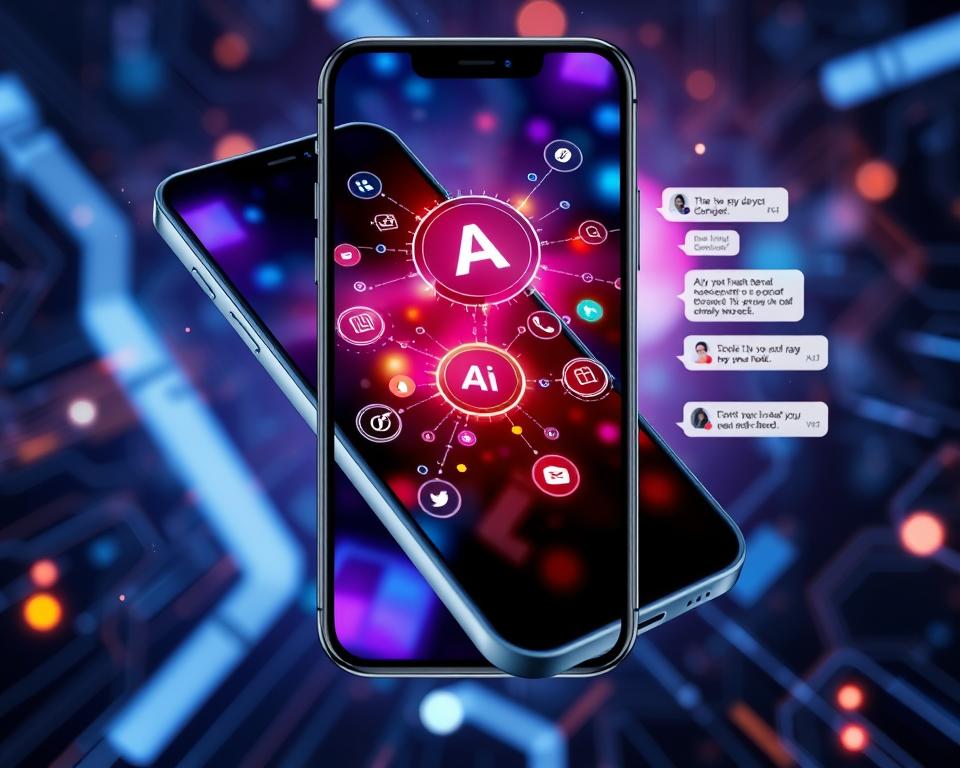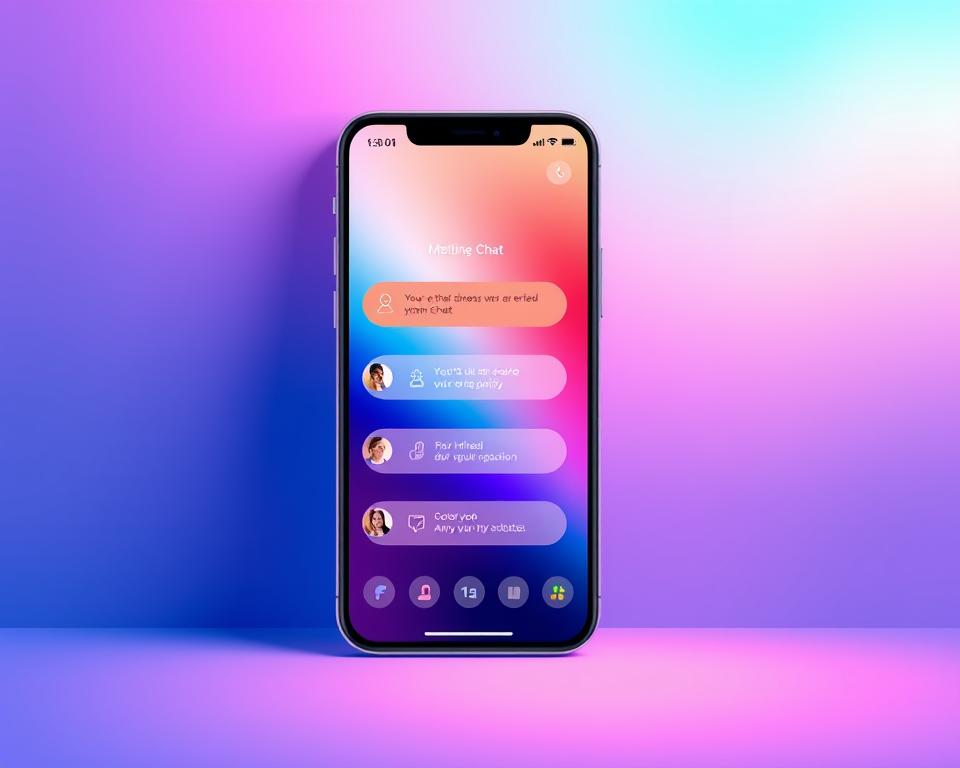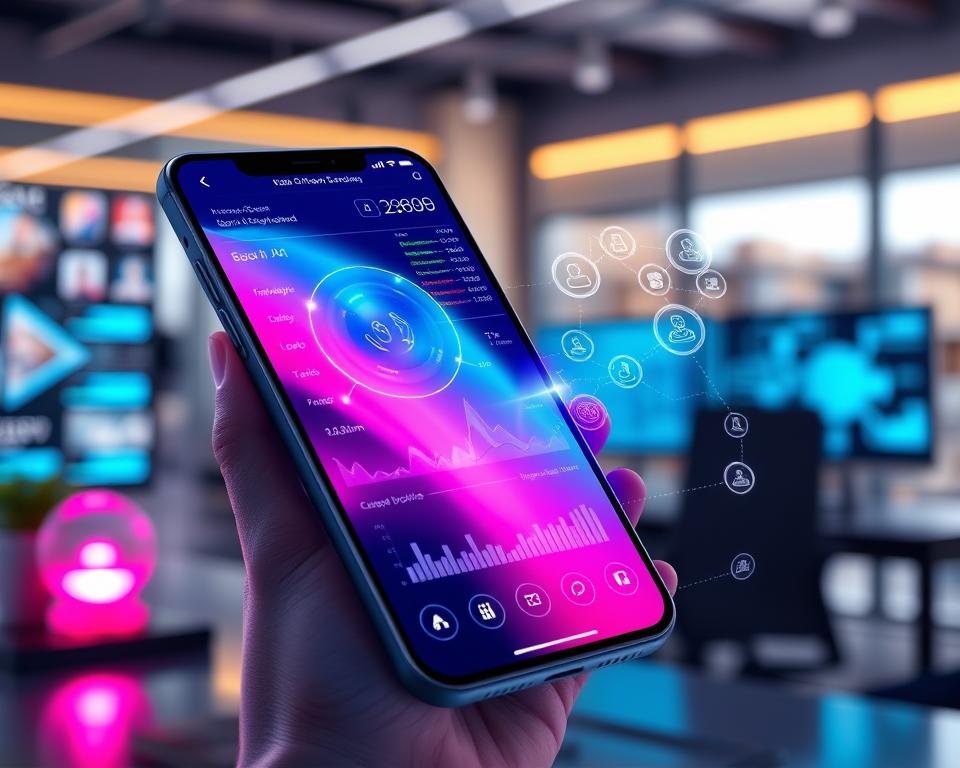Mobile app developers are seeing a big change with artificial intelligence (AI). The use of AI-powered chatbots like ChatGPT is making apps better. It’s a great way to make your app more engaging and useful.
ChatGPT, made by OpenAI, can change how users use your app. It lets you offer personalized help and automate tasks. This makes the app more enjoyable for everyone.
This guide will show you how to add ChatGPT to your app. We’ll cover the basics, what you need, and how to do it right. Whether your app is for iOS or Android, you’ll learn how to make it better with AI.
Table of Contents
Key Takeaways
- Understand the key components and technical requirements for integrating ChatGPT into your mobile app
- Discover the benefits of AI-powered conversational interfaces and their impact on user engagement
- Learn how to set up your development environment and implement ChatGPT API calls within your mobile application
- Explore best practices for designing user-friendly chat interfaces and managing real-time conversations
- Gain insights into security considerations, performance optimization techniques, and scaling strategies for your ChatGPT-enabled mobile app
Understanding ChatGPT Integration Fundamentals for Mobile Applications
Mobile app developers are looking to improve user interaction. They’re turning to AI chatbots like OpenAI’s ChatGPT. To add the ChatGPT API to your app, you need to know the basics, what’s needed, and the technical details.
Key Components of ChatGPT API
The ChatGPT API lets developers create chat interfaces in their apps. It has many features, such as:
- Language generation: It makes responses that seem like they came from a human.
- Text completion: It helps users finish writing sentences.
- Sentiment analysis: It figures out the emotional tone of messages.
- Content moderation: It filters out bad or harmful content.
Essential Prerequisites for Integration
Before adding the ChatGPT API to your app, consider these key steps:
- OpenAI API Key: Get a valid API key from OpenAI to access the ChatGPT model.
- Networking Capabilities: Make sure your app can make secure HTTP requests to the ChatGPT API.
- Data Processing: Your app needs to handle user input and the API’s responses.
Technical Requirements and Specifications
To integrate the ChatGPT API into your app, follow these technical guidelines:
| Requirement | Specification |
|---|---|
| API Endpoint | https://api.openai.com/v1/completions |
| Authentication | Bearer token (API key) |
| Request Format | JSON |
| Response Format | JSON |
Knowing these basics about the ChatGPT API helps developers integrate it smoothly. This leads to engaging, AI-powered chats in their apps.
“Integrating ChatGPT into your mobile app can unlock a new level of user engagement and interactivity, transforming the way your customers interact with your brand.”
Benefits of AI-Powered Conversational Interfaces in Mobile Apps
AI chatbots and conversational interfaces in mobile apps have changed the game. They boost user engagement and offer personalized experiences. These AI tools bring many benefits that make apps better for users.
AI chatbots are great at giving users help right when they need it. They use natural language and machine learning to understand and respond to users. This makes users happier and more loyal to the brand.
AI chatbots also make solving problems and making decisions easier for users. They guide users through tough tasks and offer advice based on what users like. This makes the app more useful and keeps users coming back.
| Benefit | Description |
|---|---|
| Improved User Engagement | AI chatbots make interactions feel natural and personal, making the app more immersive. |
| Personalized Experiences | AI chatbots use user data to give tailored advice and recommendations, making the app feel more personal. |
| Enhanced Problem-Solving | AI chatbots help users with complex tasks by offering clear guidance and smart suggestions. |
Many big companies have seen the value of AI chatbots in their apps. Sephora, Starbucks, and Capital One have used AI to improve user experiences. This has led to happier customers and more loyalty.
“AI-powered conversational interfaces have the potential to revolutionize the way users interact with mobile applications, offering a seamless and intuitive experience that truly caters to their individual needs.”
Setting Up Your Development Environment for ChatGPT Integration
To add ChatGPT to your mobile app, you need a good development setup. This guide will help you with the tools, API key setup, and testing environment. This ensures a smooth integration process.
Required Tools and Dependencies
Start by making sure your development environment has the right tools and dependencies:
- Choose a programming language and framework that works with the ChatGPT API (like Python, JavaScript, or Swift)
- Pick an integrated development environment (IDE) like Visual Studio Code, Android Studio, or Xcode
- Get the libraries and SDKs needed for API calls and handling data
- Use tools like Git and GitHub for collaboration and version control
API Key Configuration and Security Measures
To integrate ChatGPT, first get an API key from OpenAI. This key lets your app use the ChatGPT API. Keep your API key safe by following these security tips:
- Keep the API key in your app’s config files, not in the code itself
- Use strong access controls and authorization to protect your API key
- Change your API key often to avoid security risks
Testing Environment Setup
Setting up a testing environment is key for a successful ChatGPT integration. It lets you test the API, fix bugs, and check everything works before going live. Here’s how to set up your testing environment:
- Use a separate server or cloud instance for testing
- Set up your testing environment’s infrastructure, like databases and networks, to match production
- Write and run tests to check the integration works well
- Keep an eye on your testing environment’s logs and metrics to find and fix problems
By following these steps for your development setup, API key management, and testing environment, you’ll integrate ChatGPT into your app successfully.
Implementing ChatGPT API Calls in Your Mobile Application
As mobile app developers, adding ChatGPT to your apps can make them better. It lets users talk to your app in a more natural way. Here, we’ll show you how to add ChatGPT API calls to your app.
To start, get a valid API key from ChatGPT. This key lets your app use ChatGPT’s features. Keep your API key safe to protect it.
Then, make sure your API requests are right. You’ll need to use JSON, manage headers, and handle authentication. This ensures your app and ChatGPT talk smoothly.
When you get a response, handle it well. This means parsing the JSON, getting the important info, and showing it nicely to users. Also, have good error handling to deal with any problems.
For easier integration, follow best practices and use libraries or frameworks. These tools can help with formatting requests, parsing responses, and handling errors. This lets you focus on your app’s main features.
Learning to use ChatGPT API can make your app much better. It brings conversational AI and natural language processing to your users. This can lead to more interactive features, personalized help, and better user engagement.
“Integrating ChatGPT into your mobile app can elevate the user experience to new heights, fostering more natural and intuitive interactions.”
Designing User-Friendly Chat Interfaces for AI Interactions
As businesses add AI technologies like ChatGPT to their apps, making chat interfaces easy to use is key. A smooth user experience (UX) for AI chats is vital to keep customers happy and engaged.
Chat UI Best Practices
For chat UI design, keep things simple and clear. The layout should be clean, with user inputs and AI responses easy to tell apart. Use simple icons and visual hints to help users navigate the chat.
Make sure the chat bubble design is both nice to look at and easy to read.
Response Formatting Guidelines
The way AI responses are set up matters a lot for user experience. Aim for a natural, friendly tone that fits your brand. Break long answers into shorter bits and add images or emojis to make it more fun.
User Experience Optimization Tips
- Give clear instructions and help users understand what the AI chat can do.
- Use real-time response tracking and typing indicators to make the chat more interactive.
- Make it easy to switch between text and voice commands in the chat.
By following these tips, you can make a chat interface that looks good and works well. This will improve the AI interaction for your app users.
Managing Real-Time Conversations with ChatGPT API
Mobile apps are getting better, and real-time chat is key. Using AI like ChatGPT makes conversations more engaging. It’s important to manage these chats well for a great user experience.
Keeping the chat flowing smoothly is a big challenge. ChatGPT can understand and answer questions well. But, developers need to make sure the conversation makes sense and flows naturally.
- Leveraging ChatGPT’s conversational state management, which allows tracking user intents and preserving context across multiple exchanges.
- Implementing robust mechanisms for handling user interruptions, clarifications, and follow-up questions to maintain a coherent flow of the conversation.
- Designing efficient algorithms for efficient routing and dispatching of user messages to the ChatGPT API, ensuring real-time responsiveness.
Handling many chats at once is another big task. When users talk to the app at the same time, it must keep each chat unique. It also needs to use the ChatGPT API well to answer quickly and correctly.
“The key to successful real-time chat implementation is striking the right balance between seamless conversation management and efficient AI response handling.”
By tackling these challenges, developers can make the most of ChatGPT-powered real-time chat. They can create chats that are fun and focused on the user. This makes their apps stand out in a crowded market.
Handling API Rate Limits and Response Optimization
Adding ChatGPT to your mobile app can be very beneficial. But, you need to deal with API rate limits and making responses faster. Developers must solve these problems to give users a great experience and keep their apps running smoothly.
Rate Limiting Strategies
API rate limits stop too much use and make sure everyone gets a fair chance. To handle these limits well, developers can use methods like queuing requests or exponential backoff. These strategies help keep your app fast and reliable, even when lots of people are using it.
Response Caching Methods
Fast responses are key for a good user experience. Using caching, like in-memory caching or CDNs, can help a lot. It stores answers to common questions, making your app quicker and more responsive.
Error Handling Protocols
When working with the ChatGPT API, you’ll face error handling challenges. It’s important to have strong error handling to deal with API failures or network problems. This way, your app stays stable and reliable, even when things don’t go as planned.
| Technique | Description | Benefits |
|---|---|---|
| API Rate Limiting | Implementing strategies to manage API rate limits and prevent excessive usage | Ensures fair access, prevents overload, maintains application reliability |
| Response Caching | Leveraging techniques like in-memory caching or CDNs to reduce response times | Improves user experience, increases application responsiveness |
| Error Handling | Developing protocols to gracefully handle API failures, network issues, and other edge cases | Maintains a stable and reliable user experience, even in the face of unexpected API behavior |
By tackling API rate limits, improving response optimization, and setting up strong error handling, you can make your ChatGPT app great. These steps help you handle the technical parts of using the ChatGPT API and make a truly engaging app.
“Effective handling of API rate limits and response optimization is crucial for delivering a high-quality user experience in ChatGPT-powered mobile apps.”
Integrating ChatGPT into Your Mobile App: Enhancing User Interaction with AI
As mobile app developers, we’re always looking for ways to make our apps better. ChatGPT, an AI chatbot, is a great way to improve how users interact with our apps.
Adding ChatGPT to your app makes it more personal and interactive. Users can have real conversations, get answers, and find lots of information easily.
Unlocking the Potential of ChatGPT in Mobile Apps
ChatGPT can make your app do amazing things. Here are some cool ideas:
- Contextual Assistance: Give users help right when they need it, like for product info or help with orders.
- Personalized Recommendations: Use ChatGPT to suggest things based on what users like and do.
- Conversational Interfaces: Create chatbots that can talk to users about lots of things, making the app more fun.
By adding ChatGPT to your app, you can make it better in many ways. It will keep users interested and engaged with AI.
“Integrating ChatGPT into your mobile app can transform the way your users engage with your product, opening up a world of personalized and conversational experiences.”
Starting your AI journey with ChatGPT is exciting. You’ll see how it can make your app better for users.
Security Considerations and Best Practices
When you add ChatGPT AI to your mobile app, keeping user data safe is key. It’s important to protect privacy and stop bad uses of the AI. By using strong security, you make your app trustworthy and reliable.
Here are some top tips for keeping your ChatGPT safe:
- Implement strong data encryption: Lock all sensitive user data, like chats with ChatGPT, to keep it safe. Use top encryption methods to protect your users’ info.
- Enforce robust user authentication: Make users prove who they are before using ChatGPT in your app. Use things like biometric checks or multi-factor auth to keep identities safe.
- Establish comprehensive access controls: Set up strict rules for what users can do with ChatGPT. This stops misuse and makes sure users only see what they’re allowed to.
- Monitor and detect anomalies: Watch how users use ChatGPT for any odd or bad behavior. Use smart systems to spot and stop threats fast.
- Educate users on security best practices: Teach your users how to safely use ChatGPT in your app. This makes them aware of security and helps them protect their own data.
Following these security tips helps you make a mobile app that’s both powerful with ChatGPT and safe for users. This approach to mobile app security and AI integration safety builds trust, meets data protection rules, and gives users a safe and fun experience.
Performance Optimization Techniques for AI Integration
Adding AI like ChatGPT to mobile apps can really boost user interaction and satisfaction. But, it’s key to keep the app running smoothly and using resources well. Let’s look at the main ways to make AI apps perform better.
Response Time Optimization
It’s vital to make AI features quick to respond. This can be done by using smart caching, optimizing API calls, and using async operations. Quick responses mean users can enjoy AI features without waiting.
Memory Management Strategies
Good memory management is essential for AI apps to run efficiently. Developers should use memory pooling, reuse objects, and plan memory allocation carefully. This boosts app performance and reduces the chance of crashes or slowdowns.
Battery Usage Optimization
AI can use a lot of battery in mobile apps. To fix this, developers need to focus on AI performance optimization, mobile app efficiency, and battery management. This includes optimizing AI models, using power-saving modes, and managing resources with device APIs.
| Optimization Technique | Description | Key Benefits |
|---|---|---|
| Response Time Optimization | Minimizing the time it takes for AI-powered features to respond to user input | Enhances user experience, improves app responsiveness |
| Memory Management Strategies | Efficient utilization and allocation of device memory resources | Prevents memory-related crashes, maintains app stability, and optimizes performance |
| Battery Usage Optimization | Reducing the impact of AI integration on device battery life | Extends battery runtime, improves overall user experience, and ensures long-term app usability |
By using these optimization techniques, developers can make mobile apps with AI that work great. These apps will offer a top-notch user experience, be efficient, and last longer on battery.
Analytics and Monitoring for ChatGPT Integration
Adding ChatGPT to your mobile app can really boost user interaction. But, to get the most out of it, you need to track important data. This includes chatbot analytics and user interaction. These insights help improve your AI chat experience.
Measuring AI Performance Metrics
It’s key to watch how your ChatGPT integration does. Look at these important metrics:
- Conversation success rate: See how often chats meet their goals.
- Response time: Check how fast ChatGPT answers, for a better user experience.
- User satisfaction: Get feedback to see if users like the AI chats.
Analyzing Chatbot Analytics
Looking into your ChatGPT chatbot’s data can reveal a lot. Focus on these areas:
- Conversation flow: See how users move through the chat, to spot issues.
- Topic popularity: Find out what users talk about most, to improve your AI’s answers.
- User retention: Watch how often users come back, to see if your chatbot meets their needs.
| Metric | Description | Importance |
|---|---|---|
| Conversation Success Rate | Percentage of conversations that achieve their intended goals | Measures the overall effectiveness of the ChatGPT integration |
| Response Time | Average time for ChatGPT to generate a response | Ensures optimal user experience and satisfaction |
| User Satisfaction | Feedback from users on their satisfaction with the AI-powered interactions | Provides valuable insights for continuous improvement |
By keeping an eye on these analytics, you can make your ChatGPT integration better. This will improve user engagement and make your app’s AI chat more engaging.
Scaling Your ChatGPT-Enabled Mobile Application
As your app’s user base grows, it’s vital to ensure seamless scalability. You need to expand your infrastructure and use effective load balancing. This keeps your ChatGPT-powered app running smoothly and fast.
Infrastructure Requirements
To scale your app’s infrastructure, you need a careful plan. This might include:
- Vertical scaling by upgrading your server hardware, like faster processors and more RAM.
- Horizontal scaling by adding more server instances to spread out the workload.
- Using cloud-based services for scalable and flexible resources on-demand.
- Implementing caching to lessen the load on your main data sources.
Load Balancing Strategies
Effective load balancing is key to evenly distribute incoming requests. This ensures your app performs well and stays available. Here are some strategies to consider:
- Round-robin load balancing: Spreads requests evenly across available servers.
- Least connections load balancing: Sends requests to the server with the fewest active connections.
- Content-aware load balancing: Routes requests based on the type of content, to the most suitable server.
- Autoscaling: Automatically adjusts server instances based on real-time usage to keep performance optimal.
By planning your infrastructure well and using strong load balancing, your ChatGPT-enabled app can grow smoothly. It will meet the increasing needs of your users.
Conclusion
ChatGPT can change how we use mobile apps. It makes apps more user-friendly and fun. This is thanks to AI that talks to us like a real person.
We’ve seen how ChatGPT makes apps better. It keeps users interested, helps them personally, and adds cool AI features. It answers questions, gives tips, and does tasks for us. This makes apps much better.
The world of mobile apps is always changing. Using ChatGPT and other AI will help developers keep up. They can make apps that are amazing and connect with users in new ways. This leads to more innovation and better apps for everyone.



















